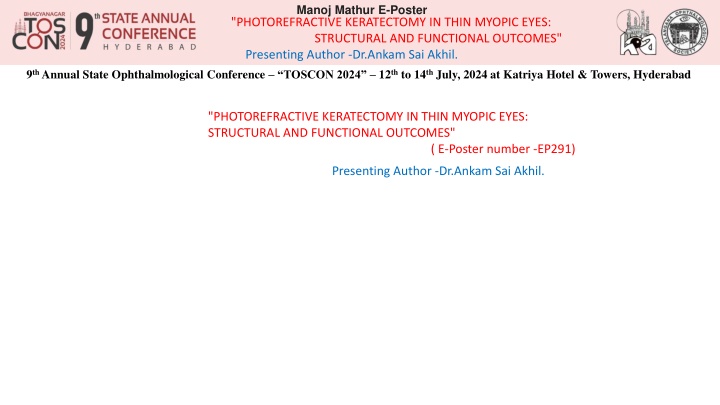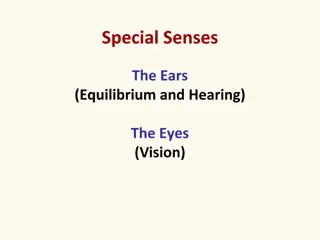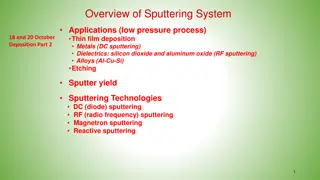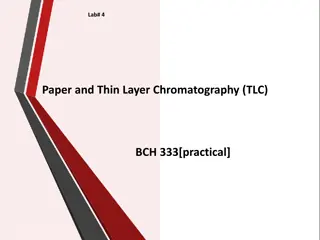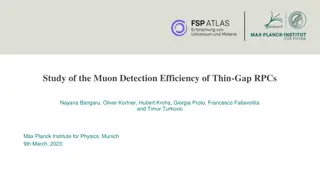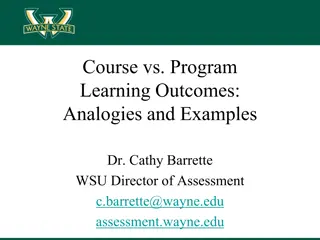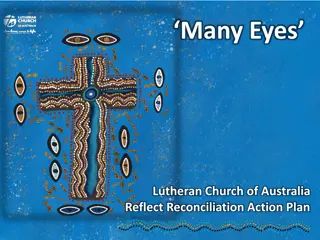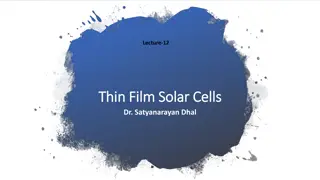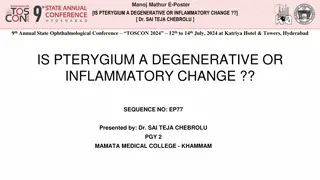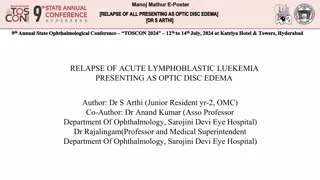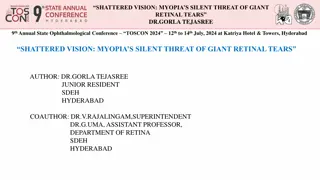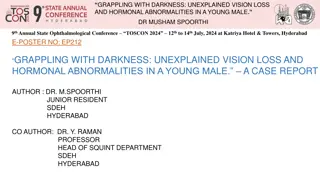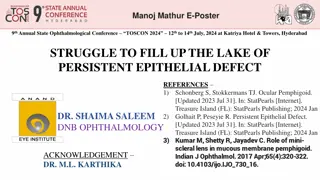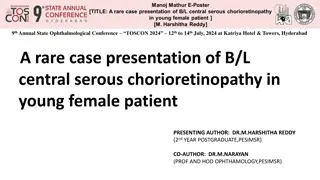Photorefractive Keratectomy in Thin Myopic Eyes: Outcomes Study at TOSCON 2024
Evaluation of photorefractive keratectomy (PRK) in thin myopic eyes at the 9th Annual State Ophthalmological Conference (TOSCON) 2024. The study aims to assess visual acuity, safety, efficacy, structural, and functional outcomes of PRK in patients with myopia and corneal thickness
Download Presentation

Please find below an Image/Link to download the presentation.
The content on the website is provided AS IS for your information and personal use only. It may not be sold, licensed, or shared on other websites without obtaining consent from the author.If you encounter any issues during the download, it is possible that the publisher has removed the file from their server.
You are allowed to download the files provided on this website for personal or commercial use, subject to the condition that they are used lawfully. All files are the property of their respective owners.
The content on the website is provided AS IS for your information and personal use only. It may not be sold, licensed, or shared on other websites without obtaining consent from the author.
E N D
Presentation Transcript
Manoj Mathur E-Poster "PHOTOREFRACTIVE KERATECTOMY IN THIN MYOPIC EYES: STRUCTURAL AND FUNCTIONAL OUTCOMES" Presenting Author -Dr.Ankam Sai Akhil. 9thAnnual State Ophthalmological Conference TOSCON 2024 12thto 14thJuly, 2024 at Katriya Hotel & Towers, Hyderabad "PHOTOREFRACTIVE KERATECTOMY IN THIN MYOPIC EYES: STRUCTURAL AND FUNCTIONAL OUTCOMES" ( E-Poster number -EP291) Presenting Author -Dr.Ankam Sai Akhil.
Manoj Mathur E-Poster "PHOTOREFRACTIVE KERATECTOMY IN THIN MYOPIC EYES: STRUCTURAL AND FUNCTIONAL OUTCOMES" Presenting Author -Dr.Ankam Sai Akhil. 9th Annual State Ophthalmological Conference TOSCON 2024 12th to 14th July, 2024 at Katriya Hotel & Towers, Hyderabad INTRODUCTION Myopia (nearsightedness) is an ocular disorder in which the optical power of the eye is too strong for the corresponding axial length. Light rays from an object at infinity entering a non-accommodating myopic eye are converged too strongly and focus in front of the retina. Though several studies have been conducted to evaluate the safety, efficacy, stability and post-operative complications of PRK, and comparison of its outcome with that of other refractive surgical procedures suchas LASIK has been done. Its safety and efficacy in terms of evidence based large case series is not available for PRK procedure when compared to LASIK Moreover, long term refractive and visual outcomes were limiting their scope of studies. Hence, there is a need for study with large sample size and longer follow up periods with refractive and visual outcomes. Moreover, it is also important to focus on the demographic location of the participating population along with the thickness of cornea in the samples, experience of surgeon and the technology followed.
Manoj Mathur E-Poster "PHOTOREFRACTIVE KERATECTOMY IN THIN MYOPIC EYES: STRUCTURAL AND FUNCTIONAL OUTCOMES" Presenting Author -Dr.Ankam Sai Akhil. 9th Annual State Ophthalmological Conference TOSCON 2024 12th to 14th July, 2024 at Katriya Hotel & Towers, Hyderabad AIM & OBJECTIVES The aim of the study is to evaluate the visual acuity, safety efficacy. structural and the functional outcomes of photorefractive keratectomy in patients who have myopia and a thin cornea < 500 um. Objectives Primary Objective: To study the efficacy and the safety of photorefractive keratectomy in myopic patients with a thin cornea. Secondary Objective: To evaluate the visual outcomes by measuring the visual acuity To evaluate the Structural outcome - Slit Lamp Biomicroscopy, Corneal topography, Corneal keratometry, and Pachymetry To evaluate functional outcomes- UCVA, BCVA, manifest Spherical and cylindrical error, safety index and efficacy index To evaluate the Quality of vision - Contrast sensitivity, patient questionnaire
Manoj Mathur E-Poster "PHOTOREFRACTIVE KERATECTOMY IN THIN MYOPIC EYES: STRUCTURAL AND FUNCTIONAL OUTCOMES" Presenting Author -Dr.Ankam Sai Akhil. 9th Annual State Ophthalmological Conference TOSCON 2024 12th to 14th July, 2024 at Katriya Hotel & Towers, Hyderabad MATERIALS AND METHODS A total of 100 eyes of 50 patients of age > 18 years with corneal thickness less than 500 um who underwent photorefractive Keratectory procedure were examined before the procedure and were followed up after procedure at day 1, at the end of first month and at the end of one year. The sludy was conducted as prospective observational study from December 2022to September 2023. The patients were informed about the details of the surgery and they gave written informed consent. The study protocol was followed as per the Institute of review board according to Declaration of Helsinki. INCLUSION CRITERIA Absence of signs of ectasia Stable refraction since last 18 months Contact lens stopped 4 weeks before surgery Absence of posterior segment pathology Refractive error of Myopia less than 7D and Astigmatism less than 3 D and central corneal thickness between 450 - 500 um. EXCLUSION CRITERIA Unstable refraction, corneal ectasias, any inflammatory ocular conditions, systemic collagen or autoimmune diseases and presence of posterior segment pathology. Myopia > 7D and Astigmatism >3D Previous history of refractive surgeries
Manoj Mathur E-Poster "PHOTOREFRACTIVE KERATECTOMY IN THIN MYOPIC EYES: STRUCTURAL AND FUNCTIONAL OUTCOMES" Presenting Author -Dr.Ankam Sai Akhil. 9th Annual State Ophthalmological Conference TOSCON 2024 12th to 14th July, 2024 at Katriya Hotel & Towers, Hyderabad DISCUSSION 64% of participants are in age range 21-30 years and 28% below 20 years and 8% above 30 years its clear most of participants below age group 30 50% are female and 50 % are male thin myopic eyes are irrespective of the gender central corneal thickness(cct) and keratometry values are reduced in 1 week than pre operative period and much more decreased after 1 month and furthur decreased after 1 year and stabilizes after 1 year . Functional outcomes UCVA are found to be reduced to at 1 week and 1 month when compared to preoperative reading and increased at 1 year manifest refraction sphere (Dsph) found to be reduced at 1 week and 1 month compared to preoperative reading and increased at 1 year manifest refraction cylinder (Dcyl) found to be reduced at 1week ,1 month,and 1 year of procedure Quality outcomes contrast sensitivity after 1 week ,1month and 1 year reduced compared to pre operative period tear film breakup time (TBUT) reduced in 1 week,1 month and 1year compared to pre operative peroid schrimers tests 1 and 2 readings are reduced in 1week,1 month and 1 year compared to pre operative peroid
Manoj Mathur E-Poster "PHOTOREFRACTIVE KERATECTOMY IN THIN MYOPIC EYES: STRUCTURAL AND FUNCTIONAL OUTCOMES" Presenting Author -Dr.Ankam Sai Akhil. 9th Annual State Ophthalmological Conference TOSCON 2024 12th to 14th July, 2024 at Katriya Hotel & Towers, Hyderabad DISCUSSION Further focus on the quality of vision evident in this study that majority of the subjects (76%) have expressed satisfaction with the result of the surgery. While being asked if surgery was a good choice, again. majority of the subjects (76% have concurred. Moreover, 78% of the subjects have been satisfied with the expected quality of vision that has been achieved. In addition, 54% of the subjects have expressed improved quality of life at work, while 65% of. the subjects have expressed improved quality of social life 72% of the subjectshave expressed improved quality of family life after the procedure. While being questioned on the quality of vision after the first week, 54% of the respondents have expressed satisfaction and 84% of the respondents have expressed full satisfaction with the result now. CONCLUSION It is clear that the procedure of photorefractive keratectomy looks to be an acceptable procedure for the patients with thin myopic eyes with corneas less than 500 um. Moreover, from the discussion of the results done above, it is evident that this procedure brings up good structural and functional outcomes. Quality of vision is also satisfactory in case of thin myopic cases, making PRK an acceptable alternative for refractive correction. Moreover, this procedure results in good quality of vision. Future study can be done by increasing the number of subjects and by increasing the period of observation after the procedure up to 4 years.
